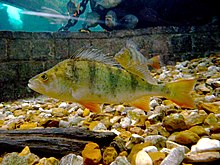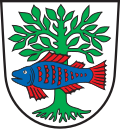bio.wikisort.org - Animal
The European perch (Perca fluviatilis), also known as the common perch, redfin perch, big-scaled redfin, English perch, Euro perch, Eurasian perch, Eurasian river perch, Hatch, poor man’s rockfish or in Anglophone parts of Europe, simply the perch, is a predatory species of the freshwater perch native to Europe and northern Asia. The species is a popular quarry for anglers, and has been widely introduced beyond its native area, into Australia, New Zealand and South Africa. They have caused substantial damage to native fish populations in Australia and have been proclaimed a noxious species in New South Wales.[3]
| European perch | |
|---|---|
 | |
 | |
Conservation status | |
| Scientific classification | |
| Kingdom: | Animalia |
| Phylum: | Chordata |
| Class: | Actinopterygii |
| Order: | Perciformes |
| Family: | Percidae |
| Genus: | Perca |
| Species: | P. fluviatilis |
| Binomial name | |
| Perca fluviatilis Linnaeus, 1758 | |
 | |
| Distribution: native range introduced range | |
| Synonyms[2] | |
Description

European perch are greenish with red pelvic, anal and caudal fins. They have five to eight dark vertical bars on their sides.[2][4] When the perch grows larger, a hump grows between its head and dorsal fin.[5]
European perch can vary greatly in size between bodies of water. They can live for up to 22 years, and older perch are often much larger than average; the maximum recorded length is 60 cm (24 in). The British record is 2.8 kg (6 lb 2 oz), but they grow larger in mainland Europe than in Britain. As of May 2016, the official all tackle world record recognised by the International Game Fish Association (IGFA) stands at 2.9 kg (6 lb 6 oz) for a Finnish fish caught September 4, 2010.[6] In January 2010 a perch with a weight of 3.75 kg (8 lb 4 oz) was caught in the river Meuse, Netherlands.[7] Due to the low salinity levels of the Baltic Sea, especially around the Finnish archipelago and Bothnian Sea, many freshwater fish live and thrive there. Perch especially are in abundance and grow to a considerable size due to the diet of Baltic herring.
Distribution and habitat
The range of the European perch covers fresh water basins all over Europe, excluding the Iberian peninsula. Their range is known to reach the Kolyma River in Siberia to the east.[2] It is also common in some of the brackish waters of the Baltic Sea.[8] They are most abundant in relatively shallow lakes and lakes with deep light penetration, and less abundant in deep lakes and those with low light penetration.[9]
European perch has been widely introduced, with reported adverse ecological impact after introduction.[2] In Australia, the species is implicated in the decline of the now-endangered native fish, the Macquarie perch.[10]
The European perch lives in slow-flowing rivers, deep lakes and ponds. It tends to avoid cold or fast-flowing waters but some specimens penetrate waters of these type, although they do not breed in this habitat.[8]
Behaviour and reproduction
The perch is a predatory species. Juveniles feed on zooplankton, bottom invertebrate fauna and other perch fry, while adults feed on both invertebrates and fish, mainly sticklebacks, perch, roach and minnows.[8] Perch start eating other fish when they reach a size of around 120 mm.[1]
Male perch become sexually mature at between one and two years of age, females between two and four.[1] In the Northern Hemisphere they spawn between February and July,[8] depositing their eggs on water plants or the branches of trees or shrubs immersed in the water.[2] There has been speculation, but only anecdotal evidence, that eggs stick to the legs of wading birds and are then transferred to other waters.[11]
Taxonomy
The first scientific description of the river perch was made by Peter Artedi in 1730. He defined the basic morphological signs of this species after studying perch from Swedish lakes. Artedi described its features, counting the fin rays scales and vertebrae of the typical perch.[12]
In 1758, Carl Linnaeus named it Perca fluviatilis.[13] His description was based on Artedi's research.[12]
Because of their similar appearance and ability to cross-breed, the yellow perch (Perca flavescens) has sometimes been classified as a subspecies of the European perch, in which case its trinomial name would be Perca fluviatilis flavescens.[14]
Fishing


European perch is fished for food and game fishing.[8] Its flesh is described as good eating, with a white, firm, flaky texture and well flavoured.[15]
According to FAO statistics 28,920 tonnes were caught in 2013. Largest perch fishing countries were Russia, (15,242 tonnes), Finland (7,666 tonnes), Estonia (2,144 t), Poland (1,121 t) and Kazakhstan (1,103 t).[8]
Baits for perch include minnows, goldfish, weather loaches, pieces of raw squid or pieces of raw fish (mackerel, bluey, jack mackerel, sardine), or brandling, red, marsh, and lob worms, maggots, shrimp (Caridina, Neocaridina, Palaemon, Macrobrachium) and peeled crayfish tails. The tackle needed is fine but strong. Artificial lures are also effective, particularly for medium-sized perch.
It is possible to fly fish for perch using artificial flies tied for the purpose. Often, the flies required are "streamers" or bait-fish imitations and use flash, colour and movement to entice a take from the perch.[16]
Predators
The European perch is a frequent prey of many fish-eating predators, such as the Western osprey (Pandion haliaetus),[17] great cormorant (Phalacrocorax carbo)[18][19] and common kingfisher (Alcedo atthis).[20][21] It is an important item in the diet of the globally threatened Dalmatian pelican (Pelecanus crispus).[22] and non avian predators include the northern pike (Esox lucius) and the Eurasian otter (Lutra lutra).[23]
Diseases and parasites
Cucullanus elegans is a species of parasitic nematode. It is an endoparasite of the European perch.[24] Juvenile perch are commonly infected by Camallanus lacustris (Nematoda), Proteocephalus percae, Bothriocephalus claviceps, Glanitaenia osculata, Triaenophorus nodulosus (all Cestoda) and Acanthocephalus lucii (Acanthocephala)[25]
Perch in culture

The European perch is Finland's national fish.[26]
It is also pictured in emblems of several European towns and municipalities, such as Bad Buchau, Gröningen and Schönberg, Plön.
References
- Freyhof, J.; Kottelat, M. (2008). "Perca fluviatilis". IUCN Red List of Threatened Species. 2008: e.T16580A6135168. doi:10.2305/IUCN.UK.2008.RLTS.T16580A6135168.en. Retrieved 19 November 2021.
- Froese, Rainer; Pauly, Daniel (eds.) (2019). "Perca fluviatilis" in FishBase. December 2019 version.
- "Redfin perch". NSW Government. Retrieved 23 January 2017.
- "Perch (Perca fluviatilis)". ARKive. Wildscreen. Archived from the original on 2017-02-02. Retrieved 25 January 2017.
- "Perch". Luontoportti. Retrieved 25 January 2017.
- "Official World Record". The International Game Fish Association. Retrieved 23 January 2017.
- "Fischdaten". Fisch-Hitparade (in German). 2010. Retrieved 23 January 2017.
- "Species Fact Sheet (incl. link to FishStat)". FAO. Retrieved 17 October 2015.
- Seekell, David A.; Byström, Pär; Karlsson, Jan (2018). "Lake morphometry moderates the relationship between water color and fish biomass in small boreal lakes". Limnology and Oceanography. 63 (5): 2171–2178. doi:10.1002/lno.10931. ISSN 1939-5590.
- "The feasibility of excluding alien redfin perch from Macquarie perch habitat in the Hawkesbury-Nepean Catchment | NSW Department of Primary Industries". www.dpi.nsw.gov.au. Retrieved 2021-01-31.
- "Is there (scientific) proof that water fowl can transport fish eggs from one water body to an other?". 2014. Retrieved 23 January 2017.
- John Thorpe (1977). Synopsis of the biological data an the Perca fluviatilis Linnaeus, 1758 and Perca flavescens Mitchill, 1814 (PDF). FAO. ISBN 9251005044.
- Eschmeyer, William N.; Fricke, Ron & van der Laan, Richard (eds.). "Perca fluviatilis". Catalog of Fishes. California Academy of Sciences. Retrieved 12 September 2020.
- Bailly, N (2015). "Perca fluviatilis flavescens (Mitchill, 1814) – unaccepted". World Register of Marine Species. Retrieved 24 January 2016.
- "Perch". Scottish Government. Retrieved 30 August 2020.
- "Perch On The Fly". Fishtec. 2016-11-28. Retrieved 2018-11-12.
- "Osprey Fact File". Scottish Wildlife Trust. Retrieved 12 September 2020.
- Čech, M., Čech, P., Kubečka, J., Prchalová, M., Draštík, V. (2008). "Size selectivity in summer and winter diets of great cormorant (Phalacrocorax carbo): Does it reflect season-dependent difference in foraging efficiency?". Waterbirds. 31 (3): 438–447. doi:10.1675/1524-4695-31.3.438. JSTOR 25148353. S2CID 84199917.
{{cite journal}}: CS1 maint: multiple names: authors list (link) - Čech M., Vejřík, L. (2011). "Winter diet of great cormorant (Phalacrocorax carbo) on the River Vltava: estimate of size and species composition and potential for fish stock losses". Folia Zoologica. 60 (2): 129–142. doi:10.25225/fozo.v60.i2.a7.2011. S2CID 90464667.
{{cite journal}}: CS1 maint: multiple names: authors list (link) - Čech M., Čech P. (2015). "Non-fish prey in the diet of an exclusive fish-eater: the Common Kingfisher Alcedo atthis". Bird Study. 62 (4): 457–465. doi:10.1080/00063657.2015.1073679. S2CID 85632259.
- Čech M., Čech P (2017). "Effect of brood size on food provisioning rate in Common Kingfisher Alcedo atthis". Ardea. 105 (1): 5–17. doi:10.5253/arde.v105i1.a3. S2CID 90362897.
- "Dalmatian Pelican Pelecanus crispus". Birdlife. Retrieved 12 September 2020.
- Kloskowski, Janusz; Rechulicz, Jacek & Jarzynowa, Barbara (2013). "Resource availability and use by Eurasian otters Lutra lutra in a heavily modified river-canal system". Wildlife Biology. 19 (4): 439–451. doi:10.2981/12-104. S2CID 86028541.
- "Cucullanus elegans Rudolphi, 1802". World Register of Marine Species. Retrieved 24 January 2017.
- Kuchta, R., Čech, M., Scholz, T., Soldánová, M., Levron, C., Škoríková, B. (2009). "Endoparasites of European perch Perca fluviatilis fry: role of spatial segregation". Diseases of Aquatic Organisms. 86 (1): 87–91. doi:10.3354/dao02090. PMID 19899354.
{{cite journal}}: CS1 maint: multiple names: authors list (link) - Weaver, Fran (2014). "Iconic Finnish nature symbols stand out". thisisFinland. Finland Promotion Board. Archived from the original on 25 October 2017. Retrieved 28 January 2017.
External links
На других языках
- [en] European perch
[es] Perca fluviatilis
La perca o perca de río (Perca fluviatilis) es una especie de pez de la familia Percidae muy abundante en los ríos y lagos de casi toda Europa central y occidental, antes su distribución llegaba hasta Siberia. En la península ibérica ha sido introducida en las cuencas del noreste para ser usada en la pesca deportiva, pero está declarada como especie invasora.[2][ru] Речной окунь
Речно́й о́кунь[1], или обыкнове́нный окунь[2] (лат. Perca fluviatilis), — вид лучепёрых рыб рода пресноводных окуней семейства окунёвых (Percidae). Речной окунь широко распространён в пресных водоёмах Европы и Северной Азии (до бассейна Колымы на востоке и водоёмов северных районов Ирана и Афганистана на юге), завезён в Африку, Австралию и Новую Зеландию. Ранее считалось, что ареал речного окуня включает и водоёмы Северной Америки, которые по современным представлениям населяет самостоятельный вид жёлтый окунь (Perca flavescens).Другой контент может иметь иную лицензию. Перед использованием материалов сайта WikiSort.org внимательно изучите правила лицензирования конкретных элементов наполнения сайта.
WikiSort.org - проект по пересортировке и дополнению контента Википедии
